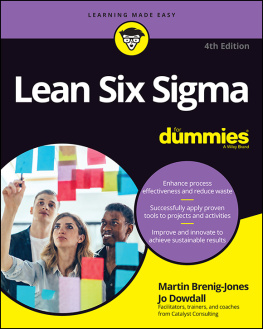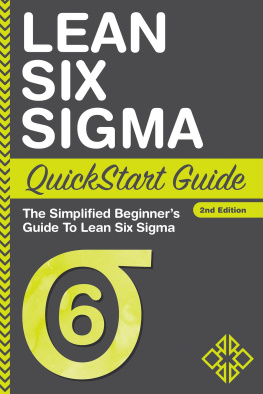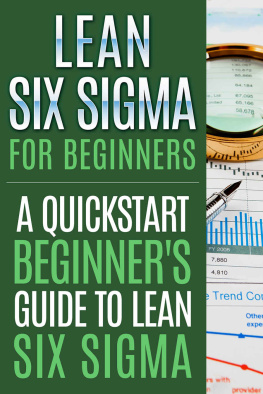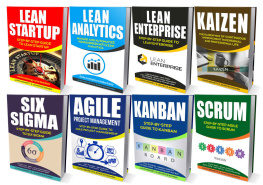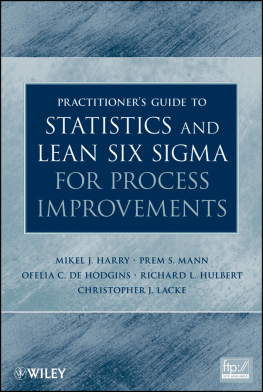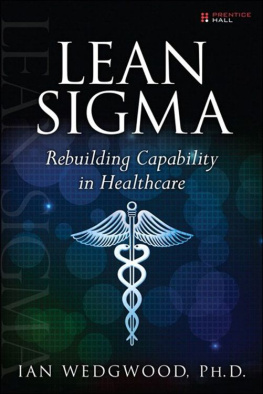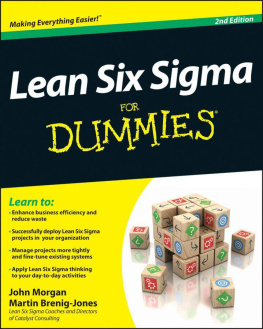George Michael L. - Lean Six Sigma: combining Six Sigma quality with lean speed. Chapter 14, Lean Six Sigma logistics
Here you can read online George Michael L. - Lean Six Sigma: combining Six Sigma quality with lean speed. Chapter 14, Lean Six Sigma logistics full text of the book (entire story) in english for free. Download pdf and epub, get meaning, cover and reviews about this ebook. City: New York, year: 2002, publisher: McGraw-Hill, genre: Home and family. Description of the work, (preface) as well as reviews are available. Best literature library LitArk.com created for fans of good reading and offers a wide selection of genres:
Romance novel
Science fiction
Adventure
Detective
Science
History
Home and family
Prose
Art
Politics
Computer
Non-fiction
Religion
Business
Children
Humor
Choose a favorite category and find really read worthwhile books. Enjoy immersion in the world of imagination, feel the emotions of the characters or learn something new for yourself, make an fascinating discovery.

- Book:Lean Six Sigma: combining Six Sigma quality with lean speed. Chapter 14, Lean Six Sigma logistics
- Author:
- Publisher:McGraw-Hill
- Genre:
- Year:2002
- City:New York
- Rating:5 / 5
- Favourites:Add to favourites
- Your mark:
- 100
- 1
- 2
- 3
- 4
- 5
Lean Six Sigma: combining Six Sigma quality with lean speed. Chapter 14, Lean Six Sigma logistics: summary, description and annotation
We offer to read an annotation, description, summary or preface (depends on what the author of the book "Lean Six Sigma: combining Six Sigma quality with lean speed. Chapter 14, Lean Six Sigma logistics" wrote himself). If you haven't found the necessary information about the book — write in the comments, we will try to find it.
George Michael L.: author's other books
Who wrote Lean Six Sigma: combining Six Sigma quality with lean speed. Chapter 14, Lean Six Sigma logistics? Find out the surname, the name of the author of the book and a list of all author's works by series.
Lean Six Sigma: combining Six Sigma quality with lean speed. Chapter 14, Lean Six Sigma logistics — read online for free the complete book (whole text) full work
Below is the text of the book, divided by pages. System saving the place of the last page read, allows you to conveniently read the book "Lean Six Sigma: combining Six Sigma quality with lean speed. Chapter 14, Lean Six Sigma logistics" online for free, without having to search again every time where you left off. Put a bookmark, and you can go to the page where you finished reading at any time.
Font size:
Interval:
Bookmark:
The following is a sample chapter from Lean Six Sigma, which explains how to impact your companys performance in each, by combining the strength of todays two most important initiatives--Lean Production and Six Sigma--into one integrated program. The first book to provide a step-by-step roadmap for profiting from the best elements of Lean and Six Sigma, this breakthrough volume will show you how to achieve major cost and lead time reductions this year; compress order-to-delivery cycle times; and battle process variation and waste throughout your organization.

Copyright 2002 by The McGraw-Hill Companies. All rights reserved. Except as permitted under the United States Copyright Act of 1976, no part of this publication may be reproduced or distributed in any form or by any means, or stored in a database or retrieval system, without the prior written permission of the publisher.
ISBN: 978-0-07-173444-8
MHID: 0-07-173444-9
The material in this eBook also appears in the print version of this title: ISBN: 978-0-07-138521-3, MHID: 0-07-138521-5.
All trademarks are trademarks of their respective owners. Rather than put a trademark symbol after every occurrence of a trademarked name, we use names in an editorial fashion only, and to the benefit of the trademark owner, with no intention of infringement of the trademark. Where such designations appear in this book, they have been printed with initial caps.
McGraw-Hill eBooks are available at special quantity discounts to use as premiums and sales promotions, or for use in corporate training programs. To contact a representative please email us at bulksales@mcgraw-hill.com.
TERMS OF USE
This is a copyrighted work and The McGraw-Hill Companies, Inc. (McGraw-Hill) and its licensors reserve all rights in and to the work. Use of this work is subject to these terms. Except as permitted under the Copyright Act of 1976 and the right to store and retrieve one copy of the work, you may not decompile, disassemble, reverse engineer, reproduce, modify, create derivative works based upon, transmit, distribute, disseminate, sell, publish or sublicense the work or any part of it without McGraw-Hills prior consent. You may use the work for your own noncommercial and personal use; any other use of the work is strictly prohibited. Your right to use the work may be terminated if you fail to comply with these terms.
THE WORK IS PROVIDED AS IS. McGRAW-HILL AND ITS LICENSORS MAKE NO GUARANTEES OR WARRANTIES AS TO THE ACCURACY, ADEQUACY OR COMPLETENESS OF OR RESULTS TO BE OBTAINED FROM USING THE WORK, INCLUDING ANY INFORMATION THAT CAN BE ACCESSED THROUGH THE WORK VIA HYPERLINK OR OTHERWISE, AND EXPRESSLY DISCLAIM ANY WARRANTY, EXPRESS OR IMPLIED, INCLUDING BUT NOT LIMITED TO IMPLIED WARRANTIES OF MERCHANTABILITY OR FITNESS FOR A PARTICULAR PURPOSE. McGraw-Hill and its licensors do not warrant or guarantee that the functions contained in the work will meet your requirements or that its operation will be uninterrupted or error free. Neither McGraw-Hill nor its licensors shall be liable to you or anyone else for any inaccuracy, error or omission, regardless of cause, in the work or for any damages resulting therefrom. McGraw-Hill has no responsibility for the content of any information accessed through the work. Under no circumstances shall McGraw-Hill and/or its licensors be liable for any indirect, incidental, special, punitive, consequential or similar damages that result from the use of or inability to use the work, even if any of them has been advised of the possibility of such damages. This limitation of liability shall apply to any claim or cause whatsoever whether such claim or cause arises in contract, tort or otherwise.
Lean Six Sigma Logistics
By Robert Martichenko of Transfreight
The previous chapter described how you could bring both suppliers and distributors/dealers into your extended supply chain and make even further gains in process speed and quality of information and performance. Given faster lead times and lower inventories, you now have an opportunity to reduce the cost and improve the quality of performance of your logistics network. What capabilities do you think Lean Six Sigma offers to the logistics network? Do you think Lean Six Sigma
1. Is a strategy to bring raw materials into a manufacturing facility exactly as the facility is running out of that particular part?
2. Is actually a distribution function, producing only what has been ordered and replenishing inventory levels to replace only what has been sold?
3. Could help you level out the demand on your resources and reduce inventories at all stages of the supply chain?
Well, if you answered all of the above, then we are off to a great start! However, I wonder today how many companies believe they are practicing Lean techniques when in fact all they are doing is postponing the ordering of raw materials? You might recall the example given in Chapter 3 (p. 34) from a visit I made to a company that thought it was great how the suppliers truck would appear just as the manufacturing line ran out of supplies. Unfortunately, that truck was bringing two months worth of supplies!
Such practices are what many people thought was the beginning and end of just-in-time (JIT). The adoption of the word Lean to replace JIT was in part an attempt to use a more descriptive term so that people would understand that JIT should be broadly construed. Thats why we have used the word Lean throughout this book.
The first thing we need to recognize is that Lean, JIT, Efficient Consumer Response, and Quick Response inventory strategies go a lot farther than simply receiving raw materials just as you are running out. Similarly, its not fair to say you are practicing these techniques just because your finished product arrives at the retailer just as the last item is purchased from the shelf.
How do you actually implement a Lean logistics program? Like a lot of Lean thinking, much of the answer is logical though counter-intuitive. The answer to these questions lies in the analysis of inventory and how a firm uses inventory to meet strategic goals.
Several times in this book weve discussed the impact of ROIC on shareholder value (see p. 12, for example). Since ROIC is the ratio of profit to invested capital, it is obvious that reducing inventory will reduce invested capital and improve ROIC. Less obvious is the fact that lower inventories will reduce cost and improve profit. Through an analysis such as what well follow in this chapter, a company will be able to demonstrate how its inventory strategies have direct implications for the companys revenue, cost of production, and ultimately profitability.
Over the years, many opinions have surfaced over how to calculate inventory carrying costs, in particular how the cost of capital should be calculated in order to recognize the opportunity costs of holding inventories. In the automotive industry, for example, which at times is plagued with inventories of raw materials, these inventories can result in high costs of production and hence can undermine an automotive manufacturers position in the market. Consequently, to remain competitive in todays markets, manufacturers need to understand the implications that inventory and related inventory costs have in terms of the firms revenue, cost of production, and ultimately profitability. Previous chapters have discussed the costs of inventory internal to factories; in concert with the process view of a business, we will now integrate that discussion throughout the extended supply chain.
Next pageFont size:
Interval:
Bookmark:
Similar books «Lean Six Sigma: combining Six Sigma quality with lean speed. Chapter 14, Lean Six Sigma logistics»
Look at similar books to Lean Six Sigma: combining Six Sigma quality with lean speed. Chapter 14, Lean Six Sigma logistics. We have selected literature similar in name and meaning in the hope of providing readers with more options to find new, interesting, not yet read works.
Discussion, reviews of the book Lean Six Sigma: combining Six Sigma quality with lean speed. Chapter 14, Lean Six Sigma logistics and just readers' own opinions. Leave your comments, write what you think about the work, its meaning or the main characters. Specify what exactly you liked and what you didn't like, and why you think so.

